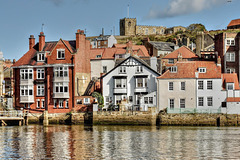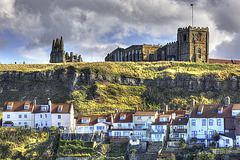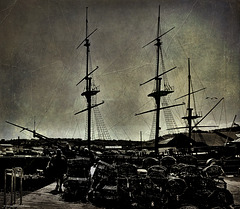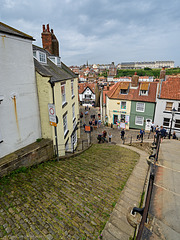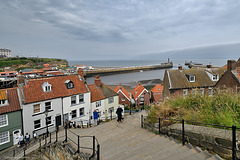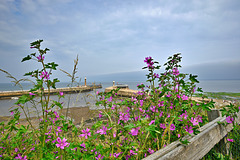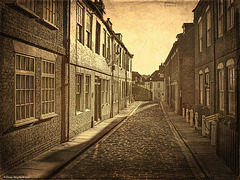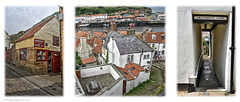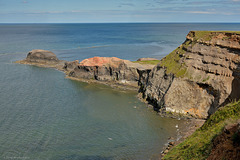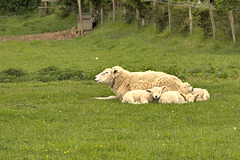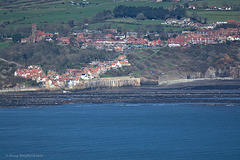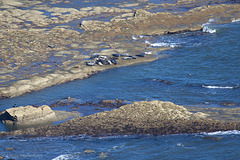
England - Coastal North Yorkshire (Sandsend to Ravenscar but mainly Whitby)
Folder: Yorkshire
Whitby is a seaside town, port and civil parish in the Borough of Scarborough and English county of North Yorkshire. It is located within the historic boundaries of the North Riding of Yorkshire. Situated on the east coast of Yorkshire at the mouth of the River Esk, Whitby has an established maritime, mineral and tourist heritage. Its East Cliff is home to the ruins of Whitby Abbey, where Cædmon, …
(read more)
Harbourside View Whitby
| |
|
|
|
Whitby is best known for its Jet jewelry, wonderful fish, Captain Cook, Whitby Abbey, Dracula and the North York Moors Railway. But where does the name come from?
Whitby was originally called Sinus Fari by the Brigantes who were a Celtic tribe controlling large sections of Northern England but by 71 AD they had been conquered by the Romans. In 657 AD Whitby became known as Streonshalh when the then Christian King of Northumbria, Oswy founded a monastery and Abbey there. The Vikings arrived in 867 AD destroying the monastery and renaming the settlement Whitby from the old Norse for White Settlement.
Whitby today is a traditional maritime town and historic port in North Yorkshire, where the River Esk meets the sea. It is located in the North York Moors National Park, designated in 1952 and on the Heritage coast, designated in 1979. There have been recorded settlements here since the Saxon period but the erection of the Abbey in 657 AD marked the birth of the town.
During the medieval period Whitby was a place of major religious significance, it was one of the earliest and most important centers of Christianity in England. After the dissolution of the monasteries in 1540 Whitby remained a small fishing community of approximately 200 people until the Elizabethan period when Alum was discovered and mining began, the port then grew in maritime and commercial significance.
In the mid 18th-19th century there were bustling shipyards, roperys and sail yards in Whitby and ships such as HM Bark Endeavour, Resolution and Adventure were built there. But by the mid the 19th century the shipbuilding and whaling industries were in decline and it was hoped that the railway would help to regenerate the town. A new development began to grow on the West side of the river designed with tourism in mind including a promenade, bandstand and luxury hotels. It is still a busy working environment with a fishing fleet, pleasure boats, ship building works, dry dock and of course the lifeboat which was one of the earliest to be established in 1802.
Cottages shelter below The Church of St. Mary
| |
|
|
|
The Church of Saint Mary is an Anglican parish church serving the town of Whitby in North Yorkshire England. It was founded around 1110, although its interior dates chiefly from the late 18th century. The church was designated a Grade I listed building on 23 February 1954. It is situated on the town's east cliff, overlooking the mouth of the River Esk overlooking the town, close to the ruins of Whitby Abbey. Church Steps, a flight of 199 steps lead up the hill to the church from the streets below. The church graveyard is used as a setting in Bram Stoker's novel, Dracula.
A Norman church was built on the site around 1110 and added to and altered over the centuries. The tower and transepts are from the 12th and 13th centuries. The tower is square and crenellated, as are the walls.
One of the oldest parts of the church is the quire which has three round-headed windows at its east end. Its side walls originally had three bays with similar windows but have been altered. It has three aumbries, one with a small piscina. The nave has five bays and is contemporary with the quire, its south wall is much altered but three external buttresses remain. When the church was enlarged in 1818 most of the north wall was removed and replaced by columns to accommodate an aisle, four large square-headed windows were inserted on the south side, the south porch was built in 1823 and a north porch built in the new annexe. The ceilings over the nave are boarded with several skylights. The transept was built in the 13th century and has three altered lancet windows in its northern arm while its southern arm is considerably changed and its windows all replaced.
The three-stage west tower has a squat appearance, its corners supported by flat buttresses and its embattled parapet is a 16th-century addition. Of its ring of eight bells, six are inscribed, "Whitby 1762 Lester and Pack of London fecit" and two were added in 1897.
Coble - Sea Salt (HFF Everyone)
| |
|
|
|
The blue and white boat on the sand is a recently rescued and refurbished traditional local Fishing Coble that was built in 1963. ‘Sea Salt' regularly leaves Whitby Harbour to harvest the sea salt which in turn will help to preserve this valuable, traditional wooden fishing boat for generations to come.
The coble is a type of open traditional fishing boat which developed on the North East coast of England. The southernmost examples occur around Hull, the type extends to Burnmouth just across the Scottish border.
The distinctive shape of the boat — flat-bottomed and high-bowed — arose to cope with the particular conditions prevalent in this area. Flat bottoms allowed launching from and landing upon shallow, sandy beaches; an advantage in this part of the coast where the wide bays and inlets provided little shelter from stormy weather. However, fishermen required high bows to sail in the dangerous North Sea and in particular to launch into the surf and to land on the beaches. The design contains relics of Norse influence, though in the main it shows Dutch origin.
Local boat-builders constructed the clinker-built cobles locally as required, without the use of plans. The craftsmanship on many boats gave them a long working life. They had a reputation as dangerous to sail for an inexperienced crew, but in the hands of experts could move both safely and speedily.
Today, surviving cobles generally use diesel engines, removing the need for the distinctively shaped lug sail.
Masts, spars and rigging, oh! and at least six sea…
| |
|
|
|
Replica of Captain Cook's HMB Endeavour (Now a tourist attraction called The Endeavour Experience)
The original HMS Endeavour, also known as HM Bark Endeavour, was a British Royal Navy research vessel that the then Lieutenant James Cook commanded to Australia and New Zealand on his first voyage of discovery from 1768 to 1771.
The original Endeavour was first registered as the Earl of Pembroke when she was built in Whitby by ship builder Thomas Fishburn in 1764.
A welcome sight! (see note)
| |
|
|
|
Church Lane and the Church Steps converge at the bottom of the hill below St. Mary's Church and Whitby Abbey Ruins.
Harbour mouth and piers from the Abbey Steps (HFF…
| |
|
|
|
The two piers in Whitby have been in existence since before the 1500's. By 1540, the two oak piers (east and west) were replaced partially, with stonework (in the reign of King Charles 1), with further work around the 1600's. Both piers were rebuilt in 1735, each measuring approximately 183m, but by 1814 the west pier was further extended to reach a length of 309m. In 1905, both the piers had new pier ends built on, each of a length of 152m.
The west pier lighthouse was built in 1831, and is a stone 83 feet column tower with a lantern on top. This light still displays a green light when shipping is expected. This lighthouse was replaced in 1914, by a wooden framework tower on 'legs, located at the seaward end of the new pier extension.
Whitby East Pier Light (or Whitby East Breakwater Light), was built in 1854. The stone built lighthouse stands 55 foot high ( approx 16 mtrs) and had a light visible from 8 miles (approx 13 km).
This too was replaced in 1914, by the new Whitby east pier light. The new light was built as a wooden framework tower on 'legs', again at the seaward end of the new pier extension. Currently operational, it displays an automated fixed red light (red for port).
Harbour flowers (HFF everyone)
Dracula Territory
| |
|
|
|
Bram Stoker arrived in Whitby in July 1890, having been recommended to visit the Yorkshire coastal town by the actor Henry Irving. He spent a week exploring Whitby alone before being joined by his wife and baby son for a family holiday. Stoker quickly became enchanted by the winding cobbled streets, dramatic cliffs and red rooftops.
From the Royal Crescent where he was staying, to the dramatic Abbey headland, Stoker gathered ideas and inspiration everywhere he went. In fact, the name of Dracula’s first victim, Swales, is taken from one of the weather-beaten gravestones which cluster around St Mary’s Church.
Stoker created the famous vampire based on a 15th-century prince Vlad Tepes, known as Dracula the ‘son of the dragon’ as it was said he impaled his enemies on wooden stakes.
Bram Stoker’s Dracula arrives on the shores of Whitby aboard a shipwrecked boat, all the sailors are found dead including the captain who has been tied to the helm. The only living creature aboard is a fierce black dog which bounds up the 199 steps leading to the Abbey: Dracula ready to inflict terror on the unexpecting town. This too is based on real life events; 5 years earlier a Russian boat had run aground on Tate Hill Sands, rearranging the name, Stoker created Demeter from Varna, the novel’s doomed vessel.
Henrietta Street, Whitby
| |
|
|
|
At the end of the street the bottom of the Church Steps can be seen joining Church Lane (see link below)
Harbour mouth and piers from the Abbey Steps (HFF everyone)
The street has a colourful history, at one time associated with smuggling and prostitution. It was called Haggerlythe until 1761 when it was renamed Henrietta Street (for his wife) by Nathanial Cholmley who rebuilt the cottages in the hope of creating a street of desirable dwellings. This dream was never properly realised and in 1786 there was a large landslide and a great part of the street disappeared; although it was subsequently rebuilt there were other landslides, the last of which was in 1923.
Whitby Trio
| |
|
|
|
Fortune’s Smokehouse
Fortune’s smokehouse and shop is one of Whitby’s most famous attractions and they can both be found on the pretty and historic east-side of Whtiby, North Yorkshire. Established in 1872 by William fortune.
The smokehouse nestles beneath the ancient cliffs, upon which St. Mary’s Church stands. It is located towards the end of a narrow cobbled street known as Henrietta Street, beyond the famous 199 steps which lead up to Whitby Abbey.
As you walk towards the smokehouse the aroma of wafting oak wood smoke fills the air and your nose will lead you towards what surely must be one of the best places in Britain to buy kippers!* The distinctive aroma will whet your appetite long before you even arrive at the smokehouse.
* A kipper is a whole herring, a small, oily fish, that has been split in a butterfly fashion from tail to head along the dorsal ridge, gutted, salted or pickled, and cold-smoked over smouldering woodchips. In Britain, Ireland and some regions of North America, kippers are most commonly consumed for breakfast.
Red Rooftops of Whitby
Bram Stoker (author of Dracula) arrived in Whitby in July 1890, having been recommended to visit the Yorkshire coastal town by the actor Henry Irving. He spent a week exploring Whitby alone before being joined by his wife and baby son for a family holiday. Stoker quickly became enchanted by the winding cobbled streets, dramatic cliffs and red rooftops.
Arguments Yard
ArgumentssYard forms a part of the old Medieval settlement of Whitby and could be closed in case of marauders from the sea. Early deeds in the 1650s refer to Thomas Argment living in the vicinity and the same spelling still occurs in 1830. It is believed Argument is actually an anglicisation of the Flemish name Argomont.
The Whitby yards, alleyways and ‘ghauts’ as they are known locally are the spaces between tiers of houses that were built back to back often into the cliffs in Whitby to house fishing families. In times past the yards of Whitby were often overcrowded areas with as many as 30 or 40 families living in abject poverty. The yard itself was the centre of that particular small community, where the children would play and the women would do their laundry, chat to their neighbours and help each other out if and when they could.
Whitby, East Pier Lighthouse (HFF everyone)
| |
|
|
|
Whitby East Pier Light (or Whitby East Breakwater Light), was built in 1854. The stone built lighthouse stands 55 foot high ( approx 16 mtrs) and had a light visible from 8 miles (approx 13 km).
This was replaced in 1914, by the new Whitby east pier light. The new light was built as a wooden framework tower on 'legs', at the seaward end of the new pier extension. Currently operational, it displays an automated fixed red light (red for port).
The view is to the east and Saltwick Nab promontory (see below)
Saltwick Nab - Scene of a 1914 maritime tragedy
| |
|
|
|
The wreck of HMHS Rohilla
HMHS Rohilla, also referred to as SS Rohilla, ran aground in October 1914 near Whitby during terrible weather conditions.
The hospital ship, carrying 229 people, was on its way to Dunkirk to pick up injured soldiers when tragedy struck.
Six lifeboats attempted to rescue people from the wreck over a stormy three-day period but 83 people sadly lost their lives. However, thanks to the brave efforts of the lifeboat crews, coastguards and local men and women 146 people were saved.
The link below gives a more comprehensive record of the disaster and rescue attempts:
www.nyma.org.uk/_webedit/uploaded-files/All%20Files/History%20Tree/23%201914%20The%20Wreck%20of%20the%20Rohilla.pdf
Ewe and trio
Robin Hood's Bay, viewed from Ravenscar
Living on the edge
| |
|
|
|
Basking in spring sunshine on the cliff edge (184 m, 604 ft). Ravenscar North Yorkshire.
Sunbathers and swimmers
| |
|
|
|
Seals at Old Peak or South Cheek Ravenscar, located below the cliffs. The colony consists of approximately 300 animals. Both grey and common seals are found here, common seals are actually the less numerous of the two resident UK seal species.
Jump to top
RSS feed- Latest items - Subscribe to the latest items added to this album
- ipernity © 2007-2024
- Help & Contact
|
Club news
|
About ipernity
|
History |
ipernity Club & Prices |
Guide of good conduct
Donate | Group guidelines | Privacy policy | Terms of use | Statutes | In memoria -
Facebook
Twitter

